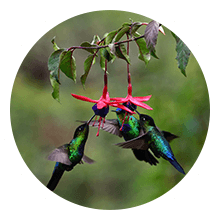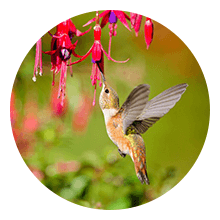Fuchsia Flowers attract bees and hummingbirds
In Europe, we mainly see bees and bumblebees flying from one fuchsia flower to the next while collecting their precious nectar. Bella Fuchsias bloom abundantly and each and every single blossom provides nectar for the bees. A very bee-friendly flower!
The love of the hummingbird
In South America, the natural environment of the fuchsia plant, the hummingbird plays the main part in pollination. This bird has a truly extraordinary relationship with the fuchsia plant.
Many fuchsia varieties are originally from South America, as is the hummingbird, the smallest bird on earth. The hummingbird is also the only bird that can fly backwards! This special talent is due to the bird’s wings that can go up and down 50 times a second. When you see a hummingbird for the first time, you will probably notice that it has a very long beak.

The hummingbird feeds on nectar and prefers orange and red flowers. These are the flowers they can see best. For the hummingbird, the colour is more important than the flower’s scent. In fact, the hummingbird does not really care about the scent. Many fuchsia flowers are indeed scentless and have orange-red blossoms. No wonder the hummingbird naturally falls in love with the fuchsia.
Variety of fuchsia flowers
There are more than 100 varieties of fuchsia plants and each fuchsia flower has a slightly different form. Amazingly, each fuchsia variety is pollinated by a very specific hummingbird. Why is that? During thousands of years, fuchsia plants and hummingbirds have built an evolutionary love affair. Both the shape of the blossom and the length of the bird’s beak have co-evolved; they are a perfect match!

The fuchsia plant provides the hummingbird with food. It is truly amazing to see how such a little bird seems to flirt with a fuchsia flower. Just like a little helicopter, the hummingbird hovers in the air as it dips its long beak into the flower. The beak becomes dusted with pollen, some of which is transferred to the next flower the hummingbird visits. By transferring pollen from one fuchsia to another, the hummingbird assists in plant reproduction. No wonder the fuchsia and the hummingbird have such an amazing friendship!